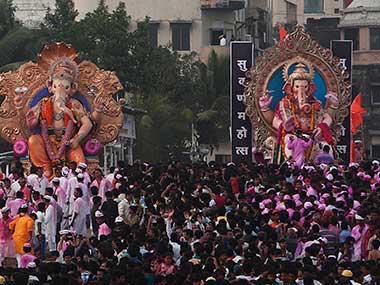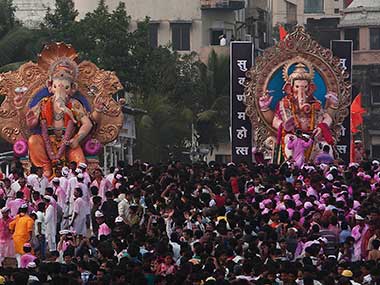When Lokmanya Tilak transformed the usual Ganapati worship of Maharashtrian homes into a new tradition of public worship in 1893, he had two intentions: one, the social purpose of bridging the gap between the Brahmins and others; and two, the political objective of using the event as a platform to evoke nationalist fervour against the British. Even the colonial rulers dared not stop him. The Ganesh festival thus provided the platform for both reforms and opposition to foreign rule. Post-Independence, such public worship has become a tradition, a practice to set up a large idol, larger the better, at almost every street corner, for worship. But while the original objective of nationalistic fervour no longer exists, the grip of politicians did not ease. In fact, it has only tightened. [caption id=“attachment_1122961” align=“alignleft” width=“380”]  Opium of the political class? Reuters[/caption] No one has so far attempted to reform these public celebrations of Ganpati, which has spread to some places even outside of Maharashtra though even Tilak was not able to get traction for it elsewhere. It is possible that the Thane Police may have started the process of delinking worship from politics, or more precisely, from politicians. Loksatta, a Marathi daily, yesterday reported that the police have issued notices to several mandals in Thane city, a cheek-by-jowl neighbour of Mumbai, pointing out that wherever they set up the Ganpati idol, it was tantamount to being a place of religion. Therefore, it ought not to be misused for political purposes. The Religious Institutions (Prevention of Misuse) Act 1988 (misusing shrines for unlawful activities) has been cited as the basis. It is unclear if this notification covered the just concluded Dahi Handi and the soon to be held Dandiya Raas, the former a day after Janmashtami – the celebration marking the birth of Lord Krishna – and the latter the Navratri festivities. During the nine days preceding the Dusserah, Goddess Shakti or Durga is worshipped. Apparently, the notification as reported by Loksatta is not an irreligious stand of the police but evidently a means to hive off politicians and politics from the celebrations. When Bombay High Court ruled against under 18-year-olds forming human pyramids and demanded that noise levels be kept under 65 decibels and public spaces not be encroached upon for Dahi Handi, some politicians saw it as impinging on religious activity. However, when the apex court relaxed the age norm to keep only under-12 kids from participation, and mandated the use of harnesses for others to avoid grievous injuries, the religious aspect was not stressed. Some politicians honestly admitted to using the festival to connect with the people. Under this notification, what is barred? Political advertising is one, because it straightaway points to the use of the event of Ganpati for a political purpose. No political speeches either. The festivity is normally about other things done – music shows which have film music belted out by artists making it a ‘social’ event, even fashion shows though some mandals such as Lalbaugcha Raja do not see any of that, fortunately. The 1988 law is generally used to measure the integrity of a politician’s bid for either the Lok Sabha or the state legislatures because using religion or a religious place for politics, like for vote gathering, is a violation under the Representation of People Act, 1951. Such a violation could attract disqualification by the Election Commission of India. Seldom, if ever, has it been used to curb political involvement in street festivities. Argue it any which way you want, but the festivities are not devoid of the religious factor for they are part of the Hindu almanac. It may not be stressed, but it at least remains the raison d’etre for the event to be conducted. For example, you don’t see Navratri-type events organised during the summers, nor a Dahi Handi-style contest at any other time except the day after Janmashtami. Likewise, Ganpati. Politicians are involved in these celebrations that enable the organisers, either the politician himself or a close, trusted associate, to flout the rules that govern the decibel levels or digging up roads to erect pandals. And it was that political strength that saw children under 12 at the pinnacle of the human pyramids during this year’s Dahi Handi celebrations, violating the Supreme Court’s stipulations. These festivities are now part of the political process and the people have no objection to it. In the last round of civic elections even the celebrations confined within the premises of housing societies sought and acquired the monetary blessings of the corporators – perhaps the first such reverse flow. If they wanted to be re-elected, they were asked to fund the programmes in some instances. Other aspirants had to match it to remain in the reckoning. The Thane Police have taken a huge task upon themselves. But it is going to be hard to live up to. If the 1988 law is enforced, jail terms are likely for the violators. But the failure to deal with other violations during Dahi Handi and Navratri makes you wonder: Can they, will they do it?
The Thane police have issued notices to Ganpati mandals saying mandals are religious places and should not be used for politicking.
Advertisement
End of Article
Written by Mahesh Vijapurkar
Mahesh Vijapurkar likes to take a worm’s eye-view of issues – that is, from the common man’s perspective. He was a journalist with The Indian Express and then The Hindu and now potters around with human development and urban issues. see more


)
)
)
)
)
)
)
)
)



